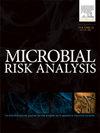奶酪微生物风险分级方法
IF 4
4区 环境科学与生态学
Q2 ENVIRONMENTAL SCIENCES
引用次数: 0
摘要
联合国粮食及农业组织(FAO)推广风险分类方法,以帮助了解奶酪等进口食品的公共卫生风险。风险分类应利用进口食品、进口商和出口国概况中的信息来确定与进口食品相关的风险。第一步是评估产品特征,第二步是考虑国家的具体控制措施。在本文中,我们介绍了利用产品特征根据微生物风险对奶酪进行风险分级的第一步。根据对英国奶酪进口数据的评估,该方法适用于六十种可能经常交易的奶酪。它使用了牛奶巴氏杀菌、成熟方法和成品奶酪中病原体生长预测等风险因素。对每个风险因素进行评分,并根据最初病原体的存在和随后生长的可能性,用总分对奶酪在边境含有存活病原体的可能性进行排序。评分范围为 0 至 6 分。以国际食源性疾病暴发和欧盟食品与饲料快速预警系统(RASFF)的通知为基准,根据奶酪类型的得分,将其划分为从极低到高四个定性风险等级之一。这些定性区间与不以风险为基础的贸易代码并不一致,因为有些代码包含了不同风险等级的奶酪。虽然注意到一些非常硬的奶酪(如帕尔马干酪)得到的风险分数最低,但与法典奶酪等级也没有很好的相关性。例如,在得分≤3 分的奶酪中,没有一种奶酪收到过 RASFF 通报或导致过疫情爆发。在与评分奶酪类型相关的疫情爆发中,83.3%的疫情爆发与评分≥5分的奶酪有关。然而,并非所有奶酪都有数据。如果需要对缺乏必要数据的奶酪进行评分,可采用读取数据的方法,但这会增加相关的不确定性。使用标准化方法对奶酪进行风险分级可以产生一致的基于风险的信息,这些信息可以在奶酪类型之间进行比较,但不能在两种分类系统(协调系统和食典系统)之间进行比较。这与两个分类系统的设计都与消费者安全无关这一事实是一致的。本文章由计算机程序翻译,如有差异,请以英文原文为准。
An approach to the microbiological risk ranking of cheeses
The Food and Agriculture Organization (FAO) promote risk categorization approaches to assist understanding the public health risk associated with imported foods such as cheeses. A risk categorization should use information from the imported food, importer and exporting country profile to establish risk associated with imported foods. The first step involves assessing the product characteristics whilst step two is intended to consider country specific controls.
In this paper, we describe the first step in the development of a risk ranking approach using product characteristics to rank cheeses based on microbiological risk. The approach is applied to sixty types that may be commonly traded, based on an assessment of UK data on cheese imports. It uses risk factors of milk pasteurization, ripening method, and predicted pathogen growth in the finished cheese. Each risk factor was scored, and the total used to rank the cheeses with respect to the likelihood of them containing viable pathogens at the border, dependent on initial pathogen presence and potential for subsequent growth. The possible range of scores was 0 to 6. After scoring, none scored 0 or 1, and 13 scored 6.
Using international foodborne disease outbreaks and EU Rapid Alert System for Food and Feed (RASFF) notifications as benchmarks, cheese types were assigned one of four qualitative risk levels, from Very Low to High, based on their scores. These qualitative intervals did not align with trade codes, which are not risk-based, as some codes included cheeses from different risk levels. Neither was there a good correlation with Codex cheese classes, although it was noted that some very hard cheeses (e.g., Parmesan) received the lowest risk scores.
When scores were compared with outbreak and RASFF qualitative data there was a good correlation. For example, of those scored, no cheese scoring ≤3 had received a RASFF notification or caused an outbreak. Of the outbreaks associated with cheese types that were scored, 83.3 % of outbreaks implicated cheeses with a score ≥5.
For the sixty cheeses presented here, the data required for scoring were available. However, data may not be available for all cheeses. Where it is necessary to score a cheese that is lacking the necessary data, a read-across approach would be a potential solution, but this would increase associated uncertainty. The use of a standardized approach to risk ranking of cheeses produced consistent risk-based information that can be compared between cheese types but not between two classification systems (Harmonised System and Codex system). This aligns with the fact that neither classification system was designed to correlate with consumer safety.
求助全文
通过发布文献求助,成功后即可免费获取论文全文。
去求助
来源期刊

Microbial Risk Analysis
Medicine-Microbiology (medical)
CiteScore
5.70
自引率
7.10%
发文量
28
审稿时长
52 days
期刊介绍:
The journal Microbial Risk Analysis accepts articles dealing with the study of risk analysis applied to microbial hazards. Manuscripts should at least cover any of the components of risk assessment (risk characterization, exposure assessment, etc.), risk management and/or risk communication in any microbiology field (clinical, environmental, food, veterinary, etc.). This journal also accepts article dealing with predictive microbiology, quantitative microbial ecology, mathematical modeling, risk studies applied to microbial ecology, quantitative microbiology for epidemiological studies, statistical methods applied to microbiology, and laws and regulatory policies aimed at lessening the risk of microbial hazards. Work focusing on risk studies of viruses, parasites, microbial toxins, antimicrobial resistant organisms, genetically modified organisms (GMOs), and recombinant DNA products are also acceptable.
 求助内容:
求助内容: 应助结果提醒方式:
应助结果提醒方式:


